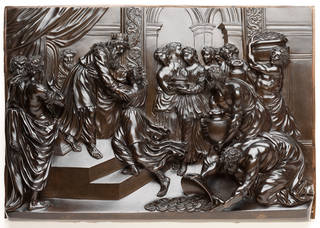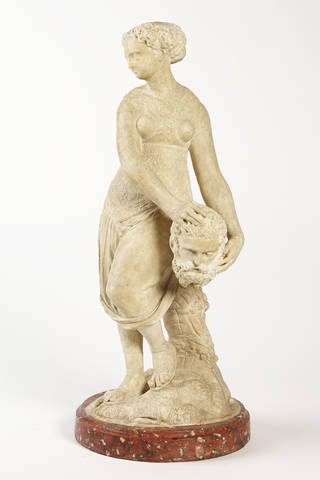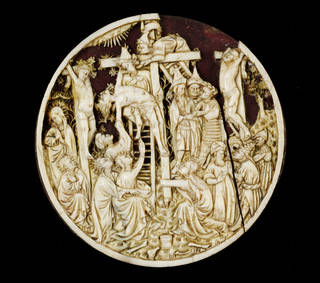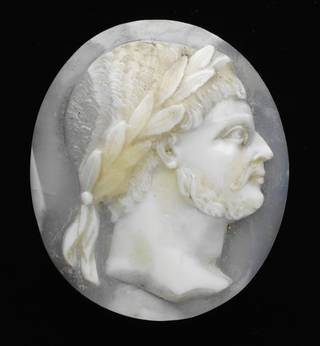The V&A's sculpture collection contains approximately 26,000 objects, including masterpieces from the Italian Renaissance, Rodin bronzes and British Neoclassical marble sculpture. Find out more about the processes used to create these magnificent pieces.
Bronze casting
Bronze is an alloy of copper and tin, and often contains lead or zinc. It is strong and durable, but can also capture the fine, complex detailing inside a casting mould. The term 'bronze' is sometimes used for other metals such as brass, which is an alloy of copper and zinc.

It has been used in Europe since antiquity to make tools, weapons, sculpture and decorative works. This continued throughout the medieval period, and in the 15th century there was a deliberate revival of ancient Greek and Roman techniques and artforms.
There are two basic methods of casting a bronze – the simple technique of sand casting which uses moulds made of compact, fine sand, or the more complex lost-wax casting, which uses wax models.
Watch the lost-wax bronze casting process in action:
Stone carving
For centuries sculptors have used stone for figurative carvings and ornamental architectural work. Different types of stone were used in different regions as sculptors used materials that were geologically available nearby. Different types of limestone were utilised all over Europe, and alabaster was popular in England, northern France, the Netherlands, Germany and Spain. Marble was commonly used in Italy, and exported to northern Europe from about 1550 onwards. As it is a particularly brittle stone, supports were used to connect arms and legs to the main part of the sculpture. These were meant to be removed once the statue was installed, although this was not always done.

As stone is so heavy, stability is important. Many free-standing marble figures in dynamic poses are portrayed with tree trunks or columns attached to the legs in order to provide a stable base. Figures displayed in niches were usually hollowed out to reduce their weight.
The tools used for stone-carving have largely remained unchanged since antiquity. A mason’s axe cuts out the basic form of the sculpture. This is further shaped or roughed out using picks, points and punches struck by a hammer or mallet. Different sizes of tool are used throughout the carving process to achieve different effects. Roughing-out tools leave deep, uneven grooves, whereas flat chisels achieve finer results and are used for finishing the surface of sandstone, limestone and marble. A flat chisel struck at 45 degree angle (the ‘mason’s stroke’) leaves a ridged channel, and its edge can be used to define lines. The serrated edges of claw chisels allow for the rapid but controlled removal of material, whilst drills can both excavate stone and create decorative effects.
Further smoothing is achieved using rasps or rifflers (metal tools with rough surfaces), or minerals such as sand or emery (stone grit). Polishes can then be applied to fine-grained stone after it has been abraded. Marble and alabaster are polished with pumice, producing a smooth, translucent and reflective surface. They can also be left partially unpolished to create different textures.
Wood carving
Regional availability determined which wood was chosen for a sculpture, along with the properties of individual trees. The hardness of a wood depends on the density of its grain. Softwoods from evergreens such as cedar and pine are coarser, less dense and easier to carve, whereas hardwoods from deciduous trees such as oak, boxwood, walnut and limewood are harder but more durable, allowing for elaborate carving and finer details.

In southern Germany sculptors favoured limewood, whilst oak was more widely used in northern Germany, the Netherlands, northern France and England. Walnut was used in France. In Italy, Spain and the Alpine regions, poplar or pine were more frequently used.
Wood is carved in a similar way to stone. The design is drawn onto a split tree-trunk. The trunk size determines the dimensions of the finished sculpture, but extra sections can be pieced in. The form of the sculpture is roughly carved with a broad axe and then shaped with tools such as the narrow axe, flat-headed chisels, gouges and skew-bladed firmers (a chisel with a hooked end for cutting folds in drapery). After carving, the surface is normally smoothed with sandpaper or other abrasives.
Although wood naturally contains moisture when first felled and can re-absorb it later in damp conditions, it can become damaged. When parts of the wood dry at different rates, cracks along the grain of the wood can form. Sculptors therefore try to minimize cracking by removing all surplus wood, especially the heartwood at the centre of a log. The holes and burrows of woodworm also affect wood carvings, and can be visible on the surface of older pieces.
Wood sculpture was sometimes painted, decorated with gilding, or embellished with glass or semi-precious stone. At the end of the 15th century, limewood sculptors in southern Germany produced unpainted wood sculptures, which were coated with transparent glazes, and sometimes tinted brown.
Ivory carving
Ivory is the dense, hard, creamy white substance that forms the tusks of mammals – though the term is also used for other similar materials. For centuries it has been highly valued by craftsmen and patrons for use in religious and secular objects.

The main source of ivory was elephant tusks from North Africa and India. Since the 10th century the bone from the Finner whale and the tusks of the Atlantic walrus and were popular in western and northern Europe. Animal bones were also used by the Embriachi workshop in northern Italy during the 15th century.
The structure of ivory varies from one species of animal to another. Elephant tusks grow outward in layers and have a cone-shaped interior cavity (the 'pulp cavity') which extends into a very small nerve along the length of the tusk.
Carving semi-precious stone and shell
Specialist craftsmen used a wide variety of materials for carvings. These ranged from gemstones and hardstones like rock crystal, to softer organic materials such as shell, coral and mother-of-pearl.

Hardstones were worked using metal tools, diamond drills and abrasive powders. Organic materials and softer mineral substances like jet and amber were carved with different types of knives and chisels. Some of these materials such as jet and coral were believed to have magical or medicinal powers, and in the medieval times rock crystal symbolised light and purity. These carvings had many functions, including cameo portraits, gems with mythological subjects, religious artefacts such as devotional pendants, containers carved in precious rock crystal, and inexpensive pilgrimage badges made of jet.
From about 1540 – 60, rulers and wealthy burghers (higher ranking medieval citizens) assembled collections of gems, cameos and other virtuoso carvings, which were displayed in special cabinets or rooms, alongside curiosities from the natural world and foreign countries.
Shell cameos
Shell cameos are much easier to cut than gemstone cameos, and the raw material is cheaper and easier to acquire. They were popular in the 16th century and again in the 18th and 19th centuries when the passion for carved gemstones led to an explosion in the market for cheaper shell cameos. They still remain popular today.
Modelling in clay
Clay is a very versatile, relatively cheap and widely available material. It can be modelled to form a unique object, or pressed into moulds to make multiple copies.

Sculptors often made rapid sketches in clay to capture initial ideas and then developed more finished models to show to patrons. They also used clay models when transferring compositions into more permanent materials such as marble.
Modelling marks are not usually visible in finished pieces of ceramic sculpture but can often be seen in ceramic models made in other mediums. Typical are rough, uneven grooves and ridges caused when clay is pushed to one side as marks are made.
Fired clay is known as 'terracotta', meaning cooked earth. The firing irreversibly changes the clay, making it stronger and suitable for different surface finishes. Clay models were sometimes fired to preserve them. Large European works, such as the ‘stemma’ (coat of arms) by Luca della Robbia (1399/1400 – 1482) were cut into pieces with cheesewire in order to fit into the kiln, and then joined together after firing.
Wax modelling

Wax models are original and unique creations that could either be works of art in their own right, or an intermediary stage in the sculptural process. Many bronze sculptures are cast from models that were first made in wax, through the highly-skilled process of lost-wax casting.
How did sculptors make wax models?
Surface decoration
The rough surface of European limestone and sandstone sculptures was usually concealed by paint, gilding, inlaid glass, or semi-precious stones. A plain white surface like those of classical Greek and Roman marble sculptures was considered the most desirable finish, so marble was rarely decorated. In actual fact, these classical sculptures would probably have originally been painted, but by the time they were rediscovered in post-classical times, the paint had worn away.

Wood sculpture was also painted, gilded or decorated with incised and punched patterns, and occasionally inset glass, though at the end of the 15th century, unpainted limewood sculptures were produced in southern Germany.
The appearance of a bronze sculpture can also vary, depending on the alloy used and the surface treatment. Chemical and organic lacquers can produce a variety of colours including black, green and reddish-brown. Bronzes can also be gilded, sometimes using the fire-gilding method – although this is now largely banned due to the toxicity of mercury vapour. In this process a paste of milled gold and mercury is spread over the sculpture which is then heated, fusing the gold to the surface and driving off the mercury. Gold lacquer can also be used to give a gilded appearance, but is not as permanent as fire-gilding.
In Renaissance Italy, terracotta sculptures were usually coloured. Luca della Robbia, developed a method of tin-glazing terracotta sculpture that had previously only been used on pottery. Della Robbia's method used pigment suspended in a tin-oxide glaze, rather than painted onto slip. The resulting enamelled terracottas were particularly durable and had an attractive, bright and reflective, surface. By the late 18th century however, unglazed terracotta had become popular with many European artists such as the French sculptor Clodion (1738 – 1814).
Find out more about our Sculpture Collection.


